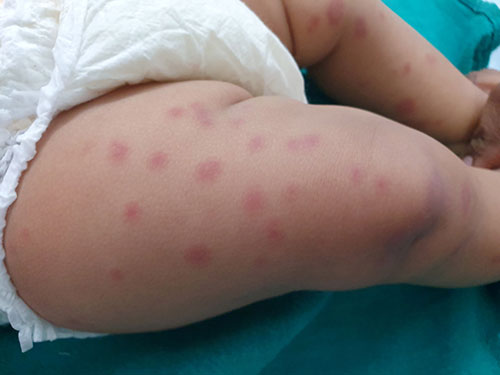An 8-month-old male infant was brought with complaints of extensive
reddish-purple cutaneous lesions over face (Fig. 1a), ears and
lower limbs (Fig. 1b) of three days duration. There was a history
of low grade fever and coryza 48-72 hours prior to the appearance of
skin lesions. The baby was active, playful and feeding well. The lesions
resolved spontaneously over the next two weeks, without any active
intervention.

(a) |

(b) |
|
Fig. 1 (a). Symmetrical purpuric plaques
on both cheeks and (b) targetoid purpuric lesions on both lower
legs in a child with acute hemorrhagic edema of infancy.
|
Acute hemorrhagic edema of infancy (AHEI), also
called Finkelstein disease or Seidlmayer disease, is a benign and rare
cutaneous leukocytoclastic small-vessel vasculitis, characterized by
palpable purpura and peripheral acral edema, seen in children aged 4 to
24 months of age. The lesions are non-pruritic, targetoid or annular
purpuric plaques or ecchymosis, symmetrically distributed over face,
auricles, and extremities with sparing of the trunk and mucosal
membranes. Systemic and visceral involvement usually does not occur and
the child remains non-toxic. It may be triggered by infection, drugs or
immunization. The cutaneous lesions generally disappear spontaneously
over 10-14 days and no specific treatment is needed. AHEI closely mimics
Henoch-Schönlein purpura (HSP), which is more common in older children
aged 3-6 years. Unlike AHEI, children with HSP commonly have visceral
involvement, may have thrombocytopenia, and present with hematuria,
acute kidney injury or arthralgia. Other differentials include erythema
multiforme, erythema infectiosum, idiopathic thrombocytopenia,
meningococcemia, Kawasaki disease, COVID-19, urticaria multiforme,
Gianotti-Crosti syndrome, and child abuse. Since clinical presentation
of AHEI is often acute and dramatic, the condition must be promptly
diagnosed to avoid unnecessary investigations or hospitalization, and to
reassure parents.

